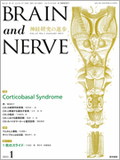Japanese
English
- 有料閲覧
- Abstract 文献概要
- 1ページ目 Look Inside
- 参考文献 Reference
はじめに
大脳皮質基底核変性症(corticobasal degeneration:CBD)と進行性核上性麻痺(progressive supranuclear palsy:PSP)の臨床診断は近年,難しいものになっている。その理由は,原著以来定着した疾患概念1,2)が,病理学的に診断が確定した症例の臨床像の見直しにより,再考を要する状況となったためである。実際,CBD,PSPと臨床診断した症例の背景病理が予測されたものと異なったり,CBD,PSPと病理診断した症例の臨床像が多様であったり,CBDとPSPの両者の臨床像を呈する症例,いわゆるハイブリッド3)が存在することなどが明らかにされている。
このような混乱を避けるため,CBDやPSPという名称は病理診断名として使用し,代わって“corticobasal syndrome”(CBS)4)や“PSP-like syndrome”(PSPS)5)という名称を臨床診断名として使用するようになってきている。現在,CBDを漏れなく正確に臨床診断するには,①臨床的にはCBSを呈しながら,病理学的にはCBDでない症例を除外し,かつ②病理学的にはCBDでありながら,臨床的にはCBSを呈していない症例を見落とさず拾い上げることが必要となる(Fig.1)。
本稿では,CBDの疾患概念の成立と,臨床像の多様性について概説した後,CBSの診断基準を提示し,最後にCBSの中から背景病理をどのように鑑別すべきか議論したい。
Abstract
Corticobasal degeneration (CBD) is a distinct neurodegenerative disorder characterized by widespread neuronal and glial accumulation of abnormal tau protein. The core characteristic clinical features of the disorder include progressive asymmetric akinetic-rigid syndrome with apraxia and features indicative of cortical dysfunction (e.g., cortical sensory loss, alien limb sign, and myoclonus) and basal ganglionic dysfunction (e.g., akinesia and dystonia). Pathological examinations of CBD patients have indicated that several proteinopathies, such as tauopathies, amyloidopathies, TDP-opathies, α-synucleinopathies, and prionopathies, may underlie the same clinical phenotype. Because of this considerable clinicopathologic heterogeneity, experts use the term corticobasal syndrome (CBS) for patients with a clinical diagnosis of CBD, and reserve CBD for those whose conditions have been diagnosed on the basis of neuropathological analyses. In this review, we have focused on the clinical aspects of CBS, including its clinical presentation, diagnostic criteria, and pathological backgrounds that are difficult to predict on the basis of clinical presentation alone. Future studies need to further characterize the natural history of CBS patients by performing serial assessments of clinical, neuropsychological, laboratory, and neuroimaging features, since this information will be necessary for designing future disease-modifying therapies that specifically target dysfunction of the 4-repeat tau protein.

Copyright © 2013, Igaku-Shoin Ltd. All rights reserved.


